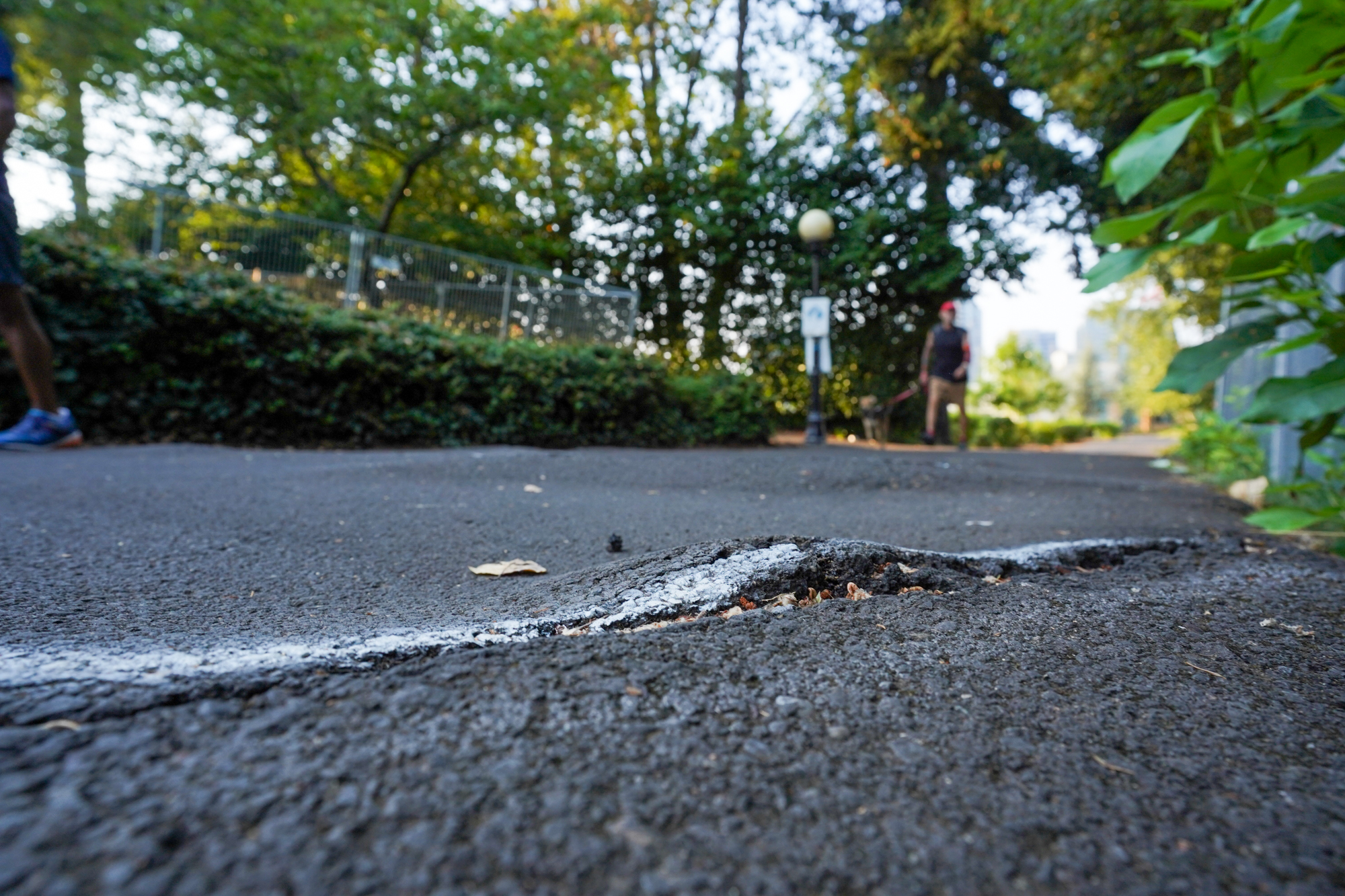
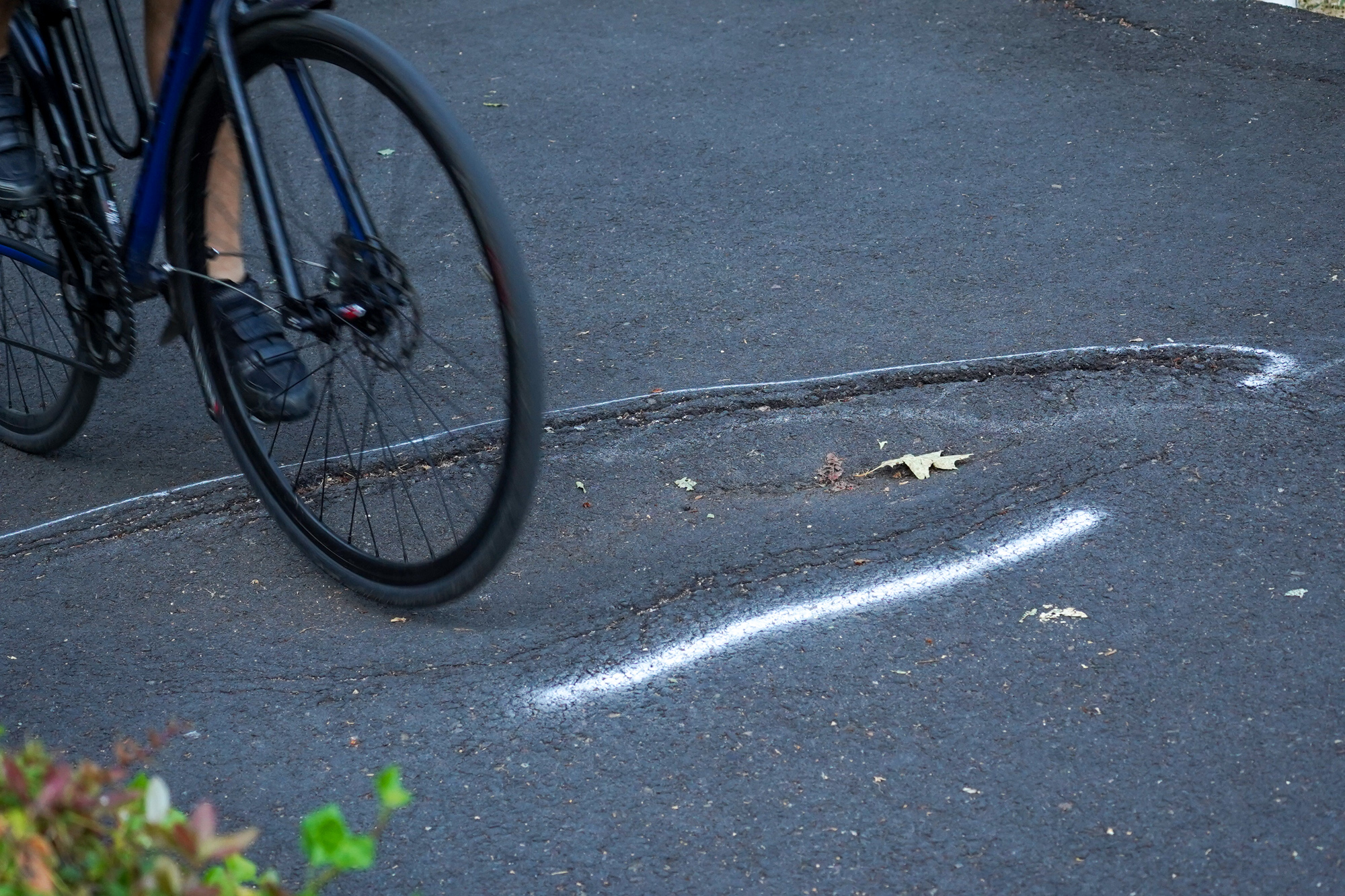
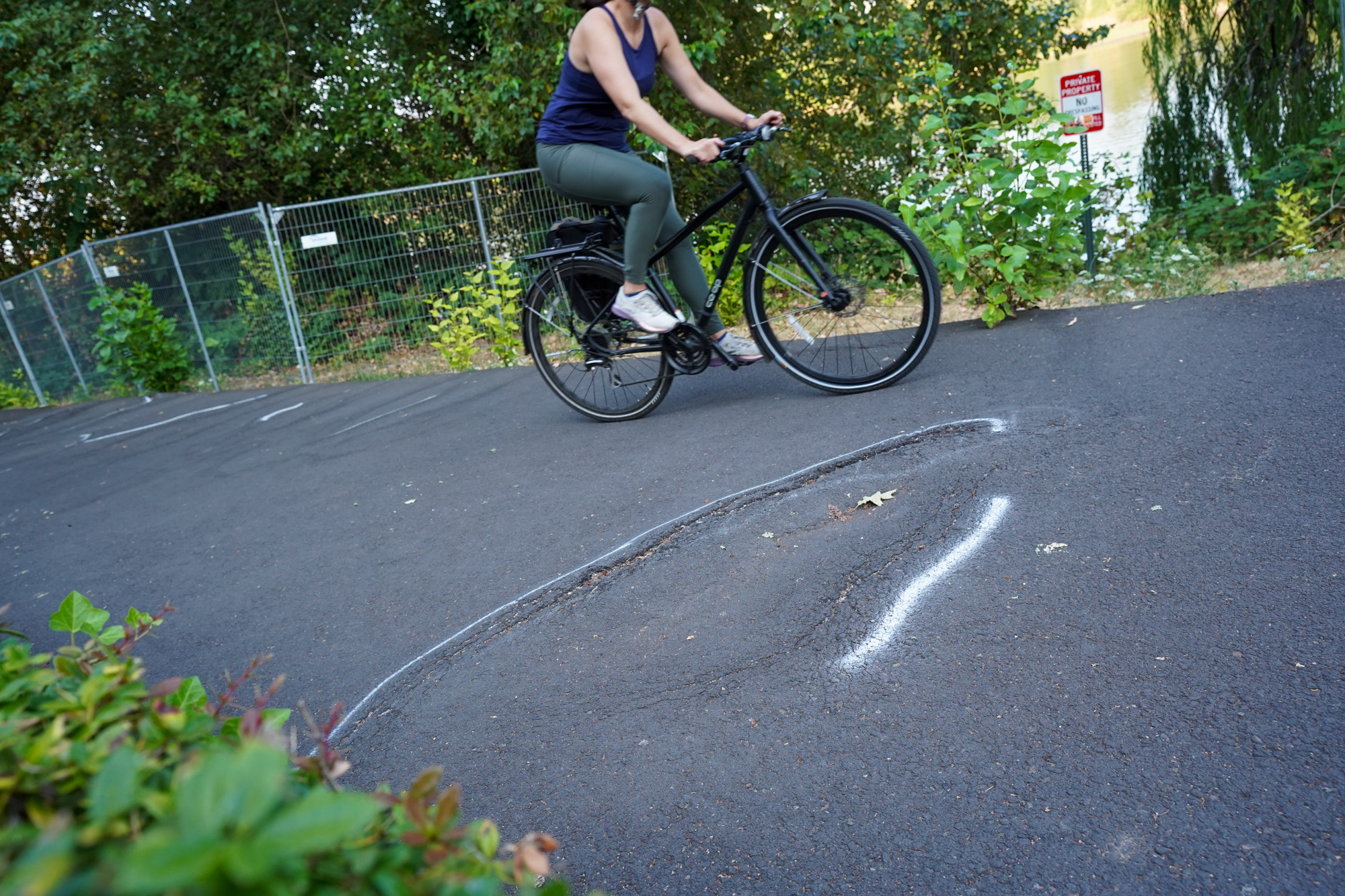

Who exactly has jurisdiction over a specific piece of bike path on the Willamette River? Downtown Portland resident Amy C. is learning the hard way that no one seems to know who’s in charge of this popular piece of public right-of-way.
On July 18th, Amy was riding her bike northbound on the Willamette River Greenway just south of the Tesla dealership and north of Cottonwood Bay Park. She told me she recalls watching a group of bike riders coming toward her, “And then my bike literally flew up in the air and slammed into a lamppost.”
Amy had run over a series of severe bumps and cracks in the pavement. She hit her head (“I saw stars after I fell,” she recalled) and got a few bruises on her shoulder, but luckily her bike and helmet took the brunt of the collision. Unfortunately, it wasn’t just any bike. Amy, who moved to Portland in 2020 and uses her bike as a volunteer for Food Not Bombs, spent years searching for her dream bike: A 1999 mixte made by Georgena Terry (a legendary builder known for making bikes that fit women’s bodies).
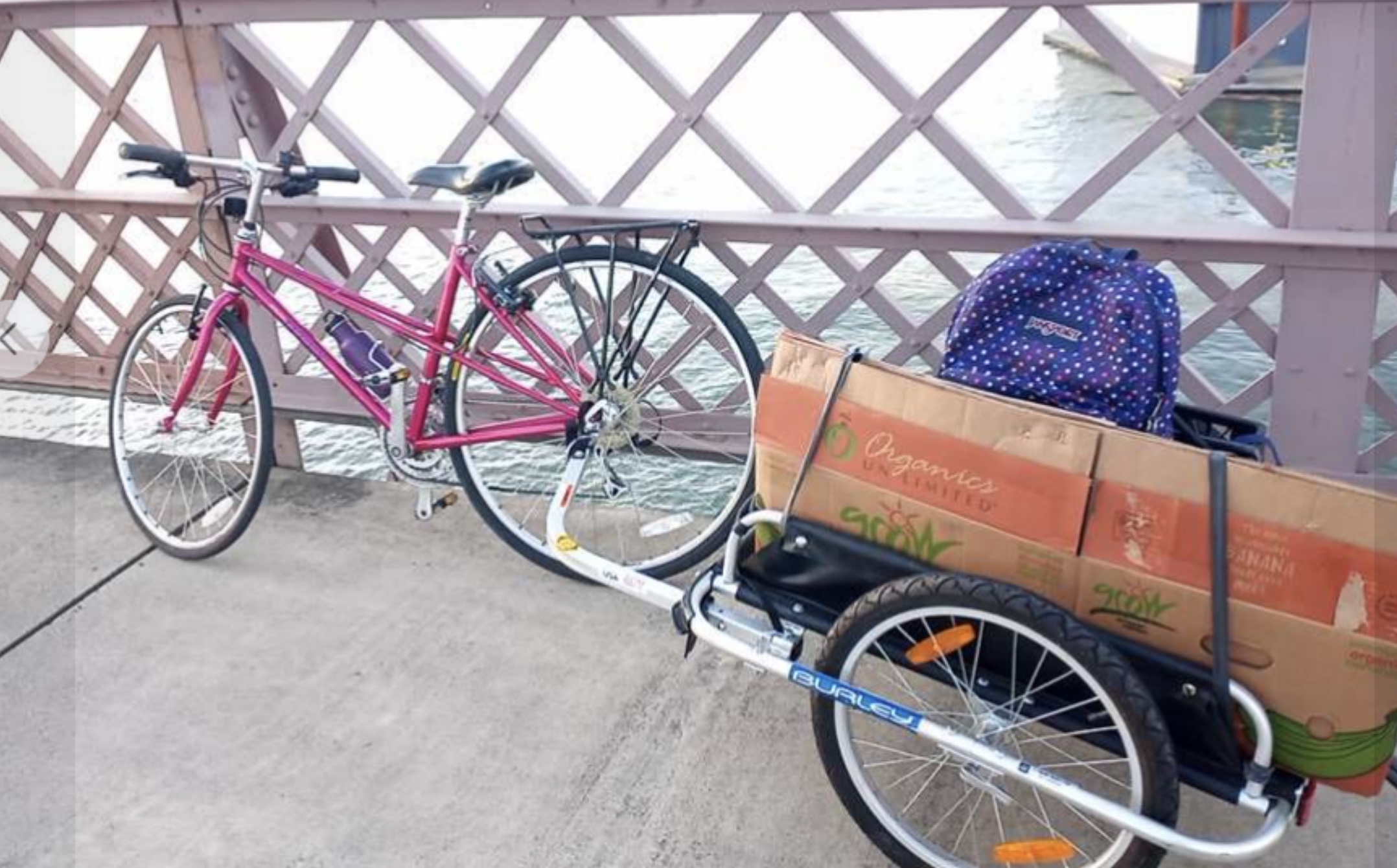
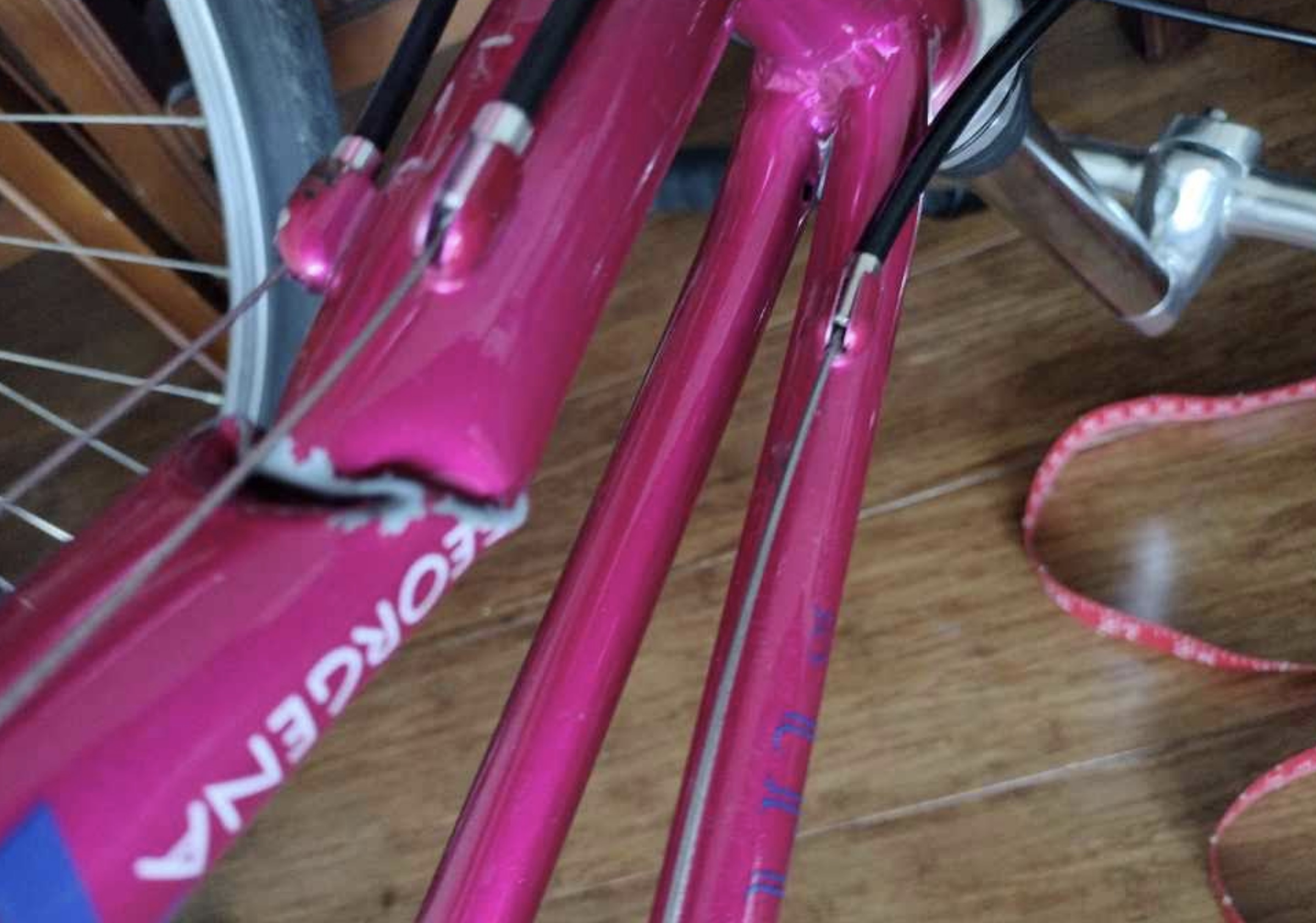
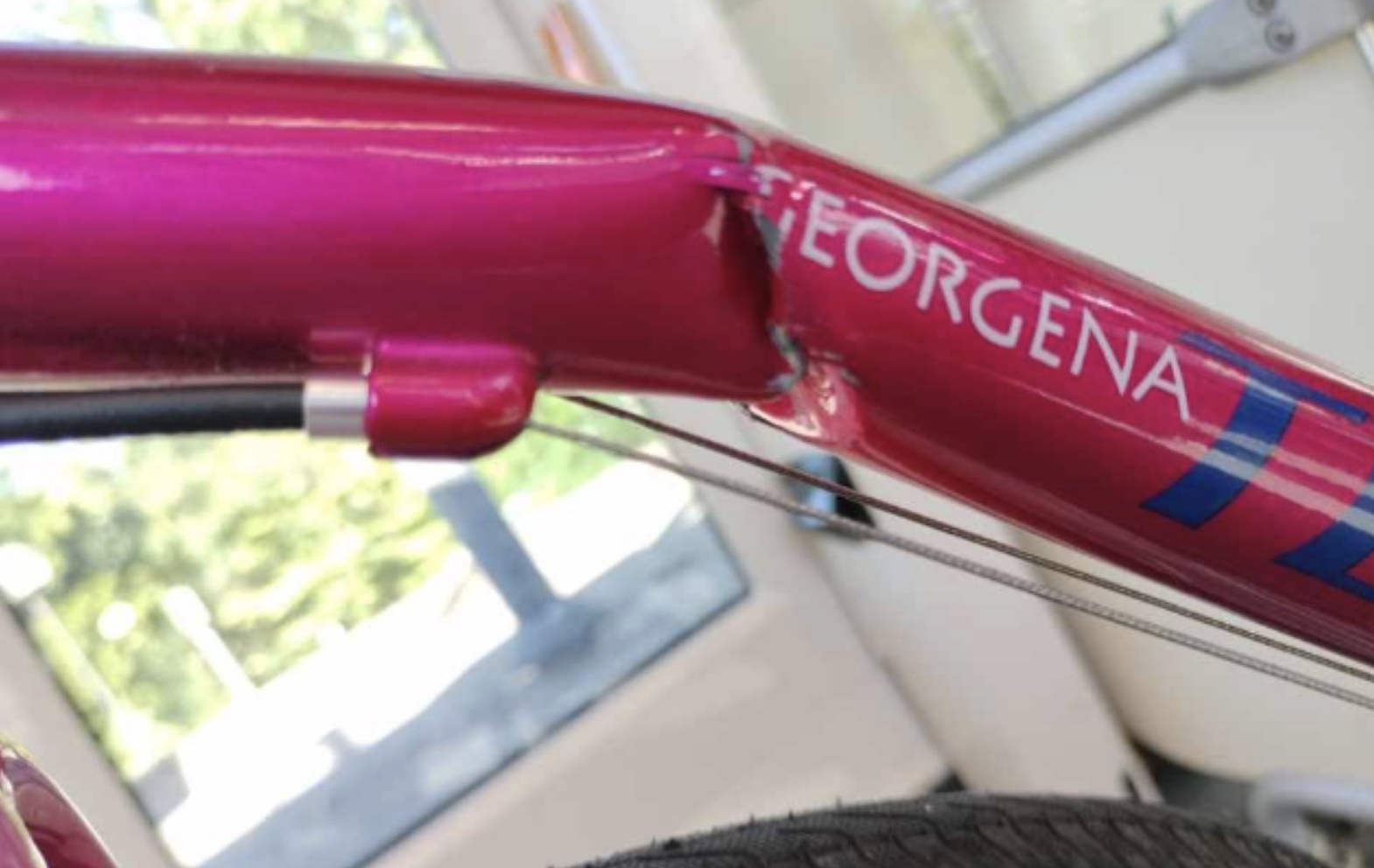
“Every agency was blaming a different agency or saying it was a responsibility of a different agency. I was really pissed. I was like, there are these hazards here and nobody’s responsible for them?”
– Amy C
The bike’s frame crumpled upon impact and is now damaged beyond repair. “I waited for this bike for 22 years and I had it two months and it was demolished,” Amy shared with me last week.
The day after the crash, Amy started researching the bumps. She called the city and told them what happened and she warned them more people would crash until the bumps get fixed. In addition to smoother pavement, she thinks a larger sign is needed. Currently, there’s only one warning sign (see below) that tells people about the bumps. It’s small and is only posted in one direction — not the direction Amy was riding. “I just wanted ample warning for people so it didn’t happen anybody else.”
Amy immediately got the runaround.
Since the path is a major bike route listed on city maps, she started with the Portland Bureau of Transportation. But they said the path was a Parks & Recreation responsibility. So Amy called the Parks bureau. They told her it was private property and she’d have to contact the owner of the adjacent building.
“Every agency was blaming a different agency or saying it was a responsibility of a different agency. I was really pissed. I was like, there are these hazards here and nobody’s responsible for them?”
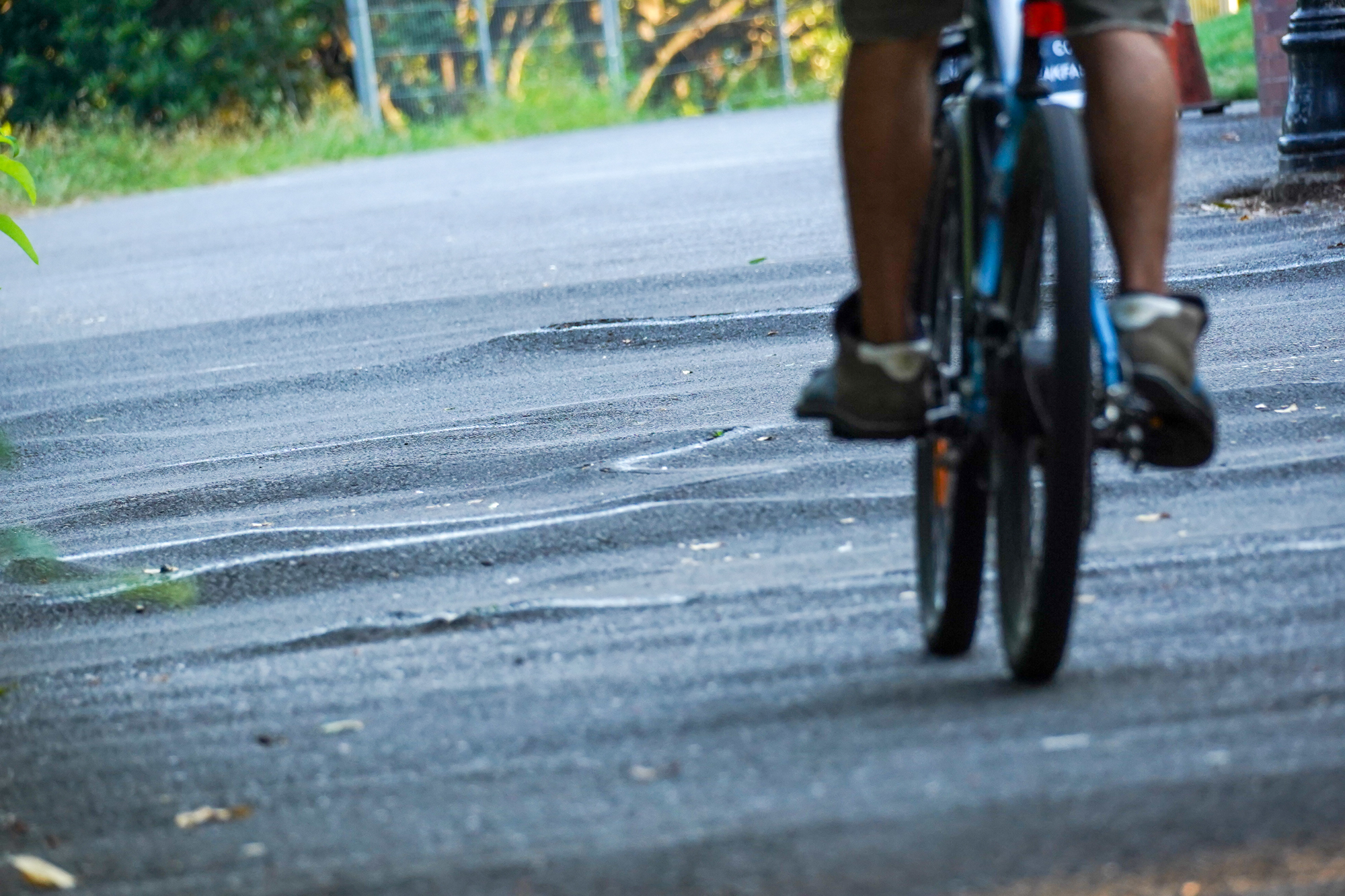
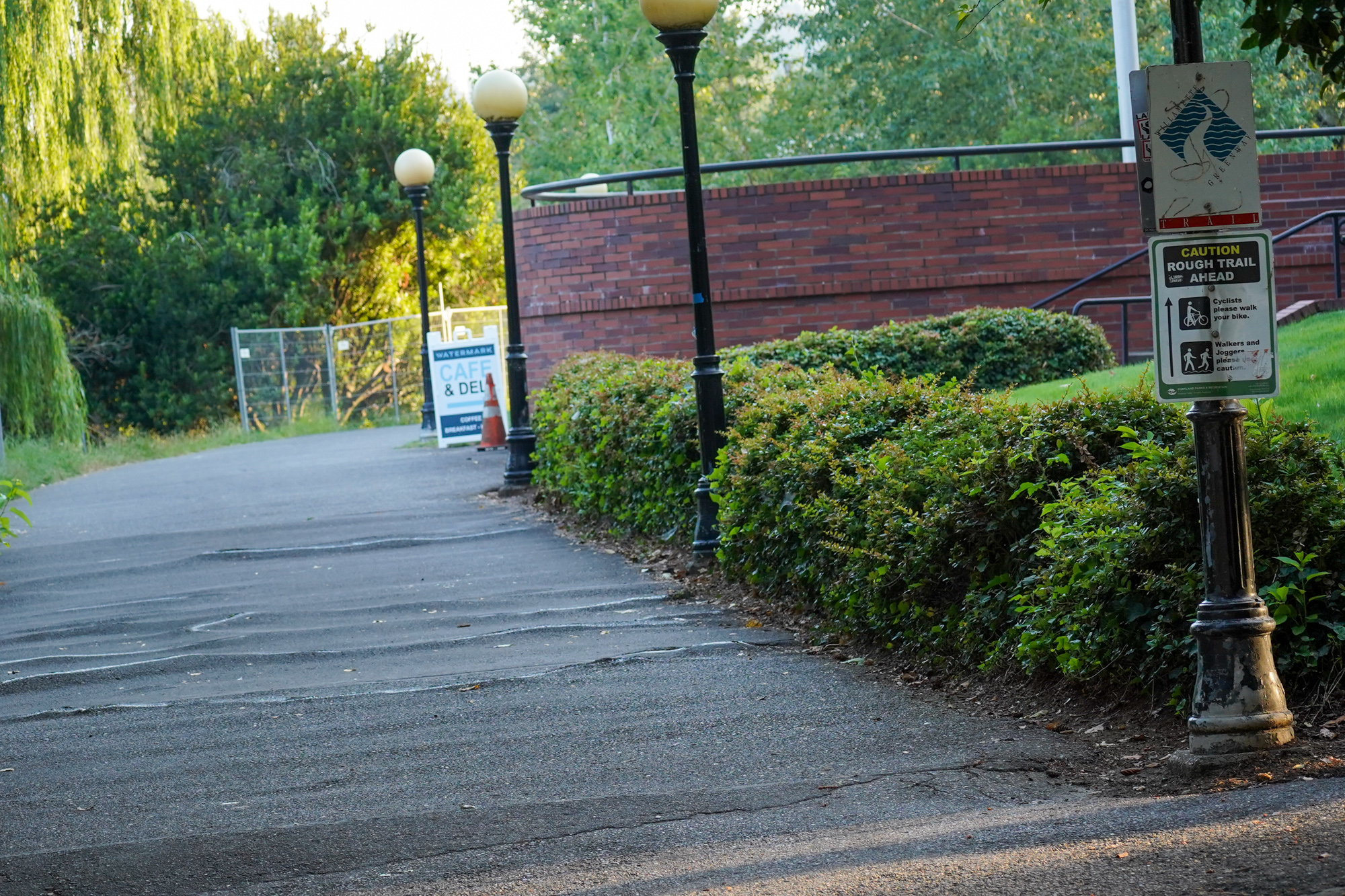
On July 26th Amy filed a claim with the City of Portland Bureau of Revenue and Financial Services. About one month later, she got a response from Senior Claims Analyst Rosalia Radich. It was denied. In the response letter, Radich wrote:
“We regret to let you know that we are denying your claim. We understand that what you experienced was very difficult and we take claims such as yours very seriously. Every claim is investigated before finalizing our decision. According to our information, the area where the tree roots are located is not owned or maintained by the City of Portland but is, instead, maintained by the private property owner of the adjacent building.”
Radich gave Amy the contact information of the building’s property manager, Hannah Knutson, who works for Jones Lang LaSalle (the building is owned by Vancouver, British Columbia-based Clarity Ventures). Amy spoke to Knutson on the phone about replacing her bike and the initial conversation was very encouraging. Then Knutson ghosted her.
With so many dead-ends and the bumps still there, Amy turned to BikePortland.
I’m familiar with this location because I’ve heard of others crashing here over the years. In 2018, a BikePortland subscriber even shared a post about it. “Can we do anything about the pavement breaks and bumps on the Willamette Greenway Trail?… It’s dangerous,” he wrote.
Chris Thomas, a lawyer with Thomas, Coon, Newton & Frost (a BikePortland advertiser) who specializes in bicycle law, was also aware of the location. “I know at least a couple of people who’ve been hurt there,” he told me in a phone call last week. He said he was “surprised” the City of Portland said it was a private property owner’s responsible. According to Thomas the jurisdiction question is important because a different set of laws applies if the responsible party is a public or private entity. Regardless, Thomas said, “I think it needs to be looked at careful. There shouldn’t be ambiguity. Confusion about who is responsible may be contributing to the bad conditions.”
It’s relatively common for the city to have a public right-of-way easement across private property. In fact, we’ve dealt with access issues several times over the years on this same path. In 2016, a condominium company near the Steel Bridge closed a gate on the path to keep people out and the city forced them to re-open it. And in 2015, business owners in Riverplace tried to prevent bike riders from using a section of the path.
Both Thomas and myself have pending inquiries with Portland Parks & Recreation about who exactly is responsible for the paths and the bumps that have hurt multiple people and have destroyed at least one beloved bicycle.
Even though the City of Portland Financial Services Bureau denied Amy’s claim and said it was between her and the property owner, Parks makes it seem like it might not be so cut-and-dry. Thomas first contacted someone at Parks about it on September 1st. He and I have both yet to receive any clarity on the issue. Last week, Parks spokesperson Mark Ross shared via email that, “This will require some analysis of various property ownership and responsibilities/easements.”
We still haven’t heard back.
Meanwhile, Amy remains frustrated and sad to have lost her dream bike, which she estimates would cost about $5,000 to replace with something custom that fits her as well. She feels like, even if jurisdiction is murky, something should be done sooner rather than later.
“If it’s a greenway, even if it’s private property, whoever establishes greenways should be paying attention to the condition of their greenways and enforcing safety measures along the way. I just don’t want anybody else to get hurt.”


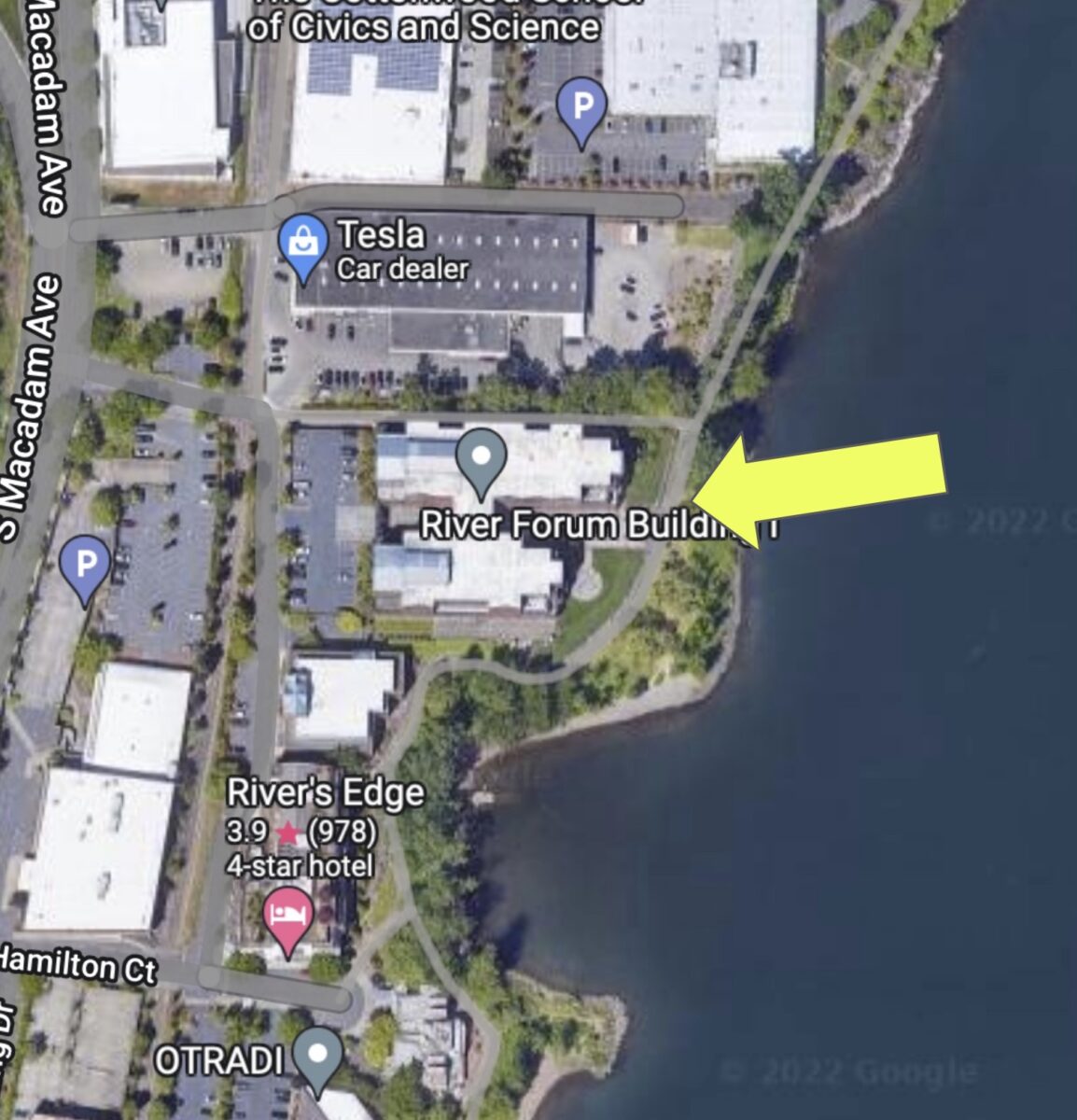
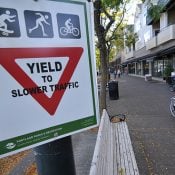
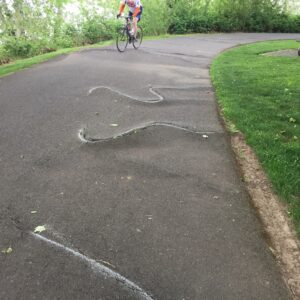

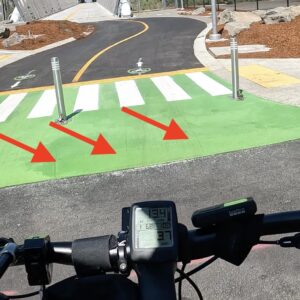
Thanks for reading.
BikePortland has served this community with independent community journalism since 2005. We rely on subscriptions from readers like you to survive. Your financial support is vital in keeping this valuable resource alive and well.
Please subscribe today to strengthen and expand our work.
The Alderwood Trail on the Eastside has the same problem.
I was going to say the same thing! The section on the North side of Alderwood is pretty darn bumpy. At least the ones in the story here are painted. But overall, this problem does not keep me off of these paths the way I completely avoid I205 and the bike and auto lanes on NE 33rd near Marine Drive.
I feel like I’m becoming a serial commenter lately. But thanks for covering this Jonathan! I’m super bummed that the poor maintenance on the Willamette Greenway is STILL hurting people and damaging their bikes. It’s been a problem for as long as I can recall. I think my first injury on this stretch due to the roots was in about 2002. Very similar to what Amy went through but thankfully my bike emerged with only minor damage at the time (broken spoke I think and the wheel needed to be re-trued, but 20 years is a long time and my memory has never been great). Since the Sellwood Bridge has been replaced, I usually cross to the East Side to avoid this poor maintenance. That or deal with the speeding autos (who have trouble maintaining their lanes for some reason), poorly maintained bike lanes (gravel, glass and blackberry brambles), and hills on Barbur or Terwilliger.
Similar to what you’re reporting here, I recall being told at some point 15-20 years ago that the reason this area was so poorly maintained was because the property owners are responsible for it and they’ve got no incentive to do beyond the bare minimum. Someone also told me that they’re not even the ones that paint the roots as a warning. Some kind samaritan does that. I think a few lawsuits and/or pressure from the city might change their minds. It’s a shame that nobody has put in a properly paved trail here at any point that would be resistant to this kind of root encroachment.
Property owners responsible for maintenance arent allowed to mess with the roots — this is one of the specific reasons the path has so many problems with them
That makes sense based on my own experiences with dealing with trees in the city. And it’s so Portland. Well-intentioned but somewhat byzantine regulation in one area preventing progress in another. I say this as a fan of the goals these regulations aim to accomplish. But it feels like this city just can’t seem to get out of it’s own way.
I’d like to add that a lawsuit against both the city and property owners would quickly sort out who is truly responsible for this stretch. Amy’s damages sound like they might be enough to warrant that route.
Another reminder that PBOT doesn’t own all the public rights of way, that there is still a lot of ambiguity in ownership out there. I seem to remember Sam Jackson to OHSU as being privately owned and parts of Airport Road are owned by the Port of Portland, not to mention all the private cul-de-sacs, the railroad rights of way, and ODOT highways. We’d all like everything to be straight forward and all that, but alas that’s not really the way that the world works.
It looks like they need to make the ‘Rough Trail Ahead, Please Walk Bikes’ sign bigger. I wonder if that is enough to clear the owner of responsibility.
The second concern is that if its privately owned and maintained, is there a risk that it could be closed down.
I wish they would paint it large and neon orange on the trails.
I don’t even remember seeing a sign there. The roots are circled, but there’s really no way to avoid all of them.
I believe the city has a ROW easement here. I don’t think the property owners have the right to close this any more than a homeowner does to close the street or sidewalk in front of their house. And I believe the owners here have a similar responsibility to maintain the path.
Its crazy that Portland would be so lax about this. Even if they do not own it, they are directing people to use these routes as a safe alternative to riding on roads. If PP&R and PBOT knew about thee dangerous but could not address tehm because they do not own them, they should have closed the route (see Esplanade) until it was made safe.
I hope Amy recovers quickly. I recommend contacting a frame builder to see about getting that frame repaired. I had a custom fork built to keep a bike I love on the road- I used Mark Simmons when he was at Norther Cycles. A quick search pulls up Bantam- I don’t have any experience with them, but they post prices which is helpful:
http://www.bantambicycles.com/repairs-and-retrofits
The Peninsula Crossing trail has been heaved in places by Black Cottonwood roots, and the trail through Kelly Point Park. The fix is to cut the root, intall root barrier and repair the asphalt- pretty basic maintenance. I hope PBOT can step up and just fix the trails.
Thanks. I did make calls inquiring about frame repair. Got quotes from about $1000 to $3000 including paint and rebuilding the bike and 1.5-2 year waiting time.
I’m just using a different bike right now.
I tend to ride on Moody and Landing, both low stress streets just to avoid the greenway. Then again, I can’t imagine riding with a trailer on the path on Moody being easy.
I too crashed there decades ago. I was hustling south and hit a sunken grade where a trench was not compacted The jolt knocked my hands off the handlebars but I stayed upright. Unable to leverage myself back to the handlebars I was headed to a sharp turn around the little bay and its riprap bank. I ditched sideways and got the mother of all road rashes.
The route should be maintained
I ride this fairly often and I think in the past year or two it’s gotten much worse. It when from “choppy” to “there goes my pannier” or “oh I didn’t realize I have a headache” somewhere between July 2021 and July 2022.
I’m not surprised it launched someone. Overall what I perceive to be the safe speed on that path tends very low.
I would think the city (parks & rec or PBOT) could still come in and fix the trail and bill the property owner for not maintaining it. That’s exactly what they threaten to do to homeowners when we get a sidewalk compliance warning. In fact, the letter they send says that I could expect to pay a lot more if the city bills me than if I get a contractor to do it for me (or DIY). Sounds to me that the city is just playing pass-the-buck.
Regardless of who is ultimately responsible, the lack of support from city employees is disheartening.
This is a city that has made it policy to encourage biking, and as part of that, make it safe to do so.
A citizen got hurt, and let the city know they were hurt, and is worried about others being hurt themselves. That should be enough for the city to get to work on addressing the issue. If the city is responsible, then fix it. If the property owner is, then the city should reach out to them.
Don’t tell someone that it’s their responsibility to hunt down the property owner to inform them.
Re: biking through Riverplace, can you still do that? A couple weekends ago I rode this path for the first time in years and when I got to riverplace I thought I saw a sign pointing bikes away/along the road? I just stayed on the street to connect to Better Naito.
You technically can. But most folks these days have given up on it, in large part because alternatives have gotten so much better and no one wants to deal with the headache of the business owners and the “Dismount” signs.
There are also a number of bumps similar to these further south.
One can avoid the bumps Amy encountered pretty easily. I commute this way nearly every day and bypass this section by going along the path adjacent to the trolley tracks and in front of the Tesla dealership. Then I encounter the bumps I refer to above.
Or like someone else mentioned, I cross the Tillicum and hit the Springwater–which is not without its own maintenance issues, e.g. falling fence line, deteriorating pavement, trash etc.
Regrettably for Amy, the most likely way to get compensated for the building owner’s lack of maintenance is to sue. Fortunately, the value of her bicycle is well within the Small Claims Court limit of $10,000. She can file without an attorney, and she may be able to find some volunteer legal resources to guide her in filing her claim.
Thanks for this. Imagine they have corporate big time attorneys and insurance departments that will fight against it. But I’ll look into it.
Amy – small claims court is very straightforward. You present your evidence and they present any counter evidence. They can certainly consult with lawyers but lawyers aren’t part of the actual proceedings.
thanks again
Really sorry about your bike. I’m shocked the frame would crumple like that. I hope someone who knows about frames will comment here and let us know whether that’s a common result of a crash to that kind of frame. I’ve crashed many times over the years with my heavy old steel frames and they have always been fine.
Frame repair is mentioned above, and I don’t think I would go that route. A frame should not fail like this from a single-bike crash. I wouldn’t go anywhere near that bike frame, repaired or otherwise. Looks like a custom build?
Edit: Is it from this builder?
https://georgenaterry.com/my-story/
this is the builder. the bike was made in 1999 in factory though. at one point, GT bikes were factory built.
Who paved this section? Whoever paved it is probably responsible for it. I bet it’s the city – if you can find the right bureau while they all play “Hot Potato.”
It’s our usual half-assed city gov’t. Vote yes on charter reform in November!
It is private property according to portlandmaps.com. That makes sense (remember the recent Tesla bike path reporting next door). The path was undoubtedly put in as a requirement from the City when the building was built. There must be an easement or some agreement that the path be kept available to the public, otherwise the owner would have closed it long ago. That agreement would spell out whether maintenance is the responsibility of Parks or the owner.
If Parks is responsible for maintenance, the claim people were wrong, and should pay reimbursement, and Parks should start maintaining it and apologize to everyone for failing for years to maintain it. If the owner is responsible, the owner should pay her, plus do all the repairs, plus be pursued by someone for ADA violations, for creating a dangerous situation, and for violating its agreement to maintain the property.
The part I disliked most is that the City, in its claim denial, didn’t include a “However, even though you should be asking the owner, not us, for reimbursement, we will be investigating to find out who is responsible for maintenance and be sure the path gets fixed by whoever is responsible”. It’s the City’s responsibility to follow up, not Amy’s, as the City seemed to think. Parks’ Mark Ross’ response was much better.
thanks for this
Hypothetically speaking, if a person wanted to raise awareness of of these bumps in a way to get attention from someone responsible for maintenance, they could, again hypothetically speaking, draw something on or around them that might be counter to the sensibilities of most people.
There was a story from the UK in 2015 of someone who went around and painted phallic drawings around potholes until the local council repaired them. I believe that they used something non-permanent like industrial chalk, so as to not cause damage.
i love this idea. who wants to do this ? lol.
I used to live out there, and the sections I knew were privately owned. Fixing things requires complying with a process that is expensive and involved.
Figuring out what needs to be done is way easier when it’s someone else’s money and time.
I’m leery of relying too heavily legal approaches that put all the burden on people who just happen to live there. Sounds like a great to get things shut down.
I still use the path sometimes, most recently on Monday. My general observations are that the overall condition of the path has been the same for many years and that many if not most cyclists ride significantly faster than the 10mph limit set there because of peds, dog walkers, kids, etc.
Destroying a bike on a 10mph path is impressive
My sentiments exactly. This is what I hate about American culture: if you smash into something, then it is your fault. Amy C. should have been watching what she is doing. Why is she blaming someone else when she crashes her bike? And then we wonder why landowners don’t want to put in bike paths. (Having said that, it may be a good idea to fix the path).
You are making assumptions.Don’t assume that Amy was not watching where she was going? Not everyone just wanders around being oblivious to their surroundings all the time.
What I hate about American culture is huge companies and/or government agencies failing to fulfill their legal and ethical responsibilities, so that innocent people suffer, then get blamed and left on their own to deal with it.
It sounds like what you are suggesting is to devolve a general sense of responsibility from governments and corporations down to individuals. In other words, when governments or corporations do something poorly, they can get off scot-free, as long as they can find a way to blame an individual victim of their poor performance.
Specifically, your requirement in this case would be that all riders must be skilled enough to ride poorly built or maintained paths, while governments and corporations do not have any responsibility to construct paths well and maintain them well.
That would suck. I think everyone and every institution should take responsibility!
I feel like you might be thinking of a different section? The photos above are of the area in front of the River Forum Building, which is commercial real estate.
But either way, folks have a reasonable expectation that the right of way is maintained in a safe fashion. Heck, it’s even the law (See Portland Code, Chapter 17 including 17.40, 17.42, and 17.28.) I’m also not sure where you’re getting the idea that this might get the path shut down because folks want some basic maintenance on the right of way. Do you think the City might abandon the easement for some reason?
An average person on a loaded bike could easy weigh 200lbs (90kg). At 10mph (15kph), I believe that’s over 20,000 Newtons of force. I’m no engineer, but that sounds like more than enough to cause this kind of damage.
Exactly, and you could have said even more. That path is there because when River Forum was seeking permits, the City undoubtedly made putting that path in as a condition of approval, and the owner agreed to it. (I’m guessing maintaining it was also a condition, but it could also be that the agreement was that the City would maintain it.)
The property has since sold at least once. If the path maintenance is the owner’s responsibility, that would be in the property records, meaning any new owner also accepted that condition, or they wouldn’t have bought the property (or they were sloppy in doing their research, which is their own fault).
This certainly isn’t a burden “on the people who live there”. It’s something the international company that paid $57 million for the property in 2019 accepted. Every homeowner in Portland who has a sidewalk in front of their home has the same obligation, and the cost of River Forum’s owner to maintain the path is about the financial equivalent of asking a typical homeowner to pay a couple dollars every few years to maintain their sidewalk.
This is the company that is at the “owner address” listed on portlandmaps.com . They have bought $2.4 BILLION in real estate since 2011: https://www.secondcityrealestate.com/
They can afford to maintain a couple hundred feet of path, and certainly have the ability to figure out how to get any permit needed.
The City is totally at fault here in either case. If maintenance is the City’s duty, it’s been derelict. If it’s been the property owners, the City has been equally derelict in not requiring them to maintain the path.
Yup
All this is true. But you still can’t sue away reality. Or we can try and then why there’s no money for anything, there’s stiff resistance to expanding any kind of infrastructure, and why people who can leave do.
I was thinking of a different section, but the same issues exist along the entire path. Not everything is owned by a corporation everyone loves to hate and not everyone who happens to live along paths is flush with cash.
I don’t know what happened, but I’m finding it difficult to visualize a violent crash on a low speed path which was caused by faults that have been in the path for years and are present throughout the length. The city is full of cracks, holes, debris, and hazards of every type and I’ll see much worse than this on my ride tonight.
I do think that too much legal action could lead to things getting shut down even if the tort system does have its function and people do need to keep things safe. The city had no trouble blocking the Esplanade for much less of a hazard. I’d demand the same if I didn’t think I could keep things safe. When it snows or there’s frozen fog, it will be wicked slick out there. So if someone gets hurt for whatever reason, just sue whoever owns the property because there’s a reasonable expectation of not being hurt when moving through an area?
I’d guess that some people would be willing to put up a real fight if they’re being held financially responsible for others they don’t want there in first place — particularly if they’re struggling to pay for things themselves.
As you said, you don’t know what happened.
That doesn’t make any sense. I never mentioned “suing” anyone. I recommended that, if the trail maintenance is the responsibility of the property owner, then the City should require the owner to fix the problems.
The trail surface was bad in 2019 when the owner bought the property. If they’re required to maintain the trail, they also had to know (or should have known) that before they bought the property. Nobody forced the maintenance agreement on them. They chose to accept it.
The idea that the City shouldn’t require an owner to do maintenance that an owner agreed to do–when the trail condition is so poor people are getting injured on it–is nuts. So is the idea that the City shouldn’t require that because the trail may go across property of other less wealthy property owners. (Plus, we’re talking about owners of in-city riverfront commercial and multi-family properties, not struggling homeowners, so it’s a moot point.)
I’ve used the trail about 10x per week for about a decade. Most is in fine condition. This one stretch is ridiculously bad in comparison. The idea that the City shouldn’t require an owner to live up to a maintenance agreement because there are other places in Portland that are worse is also nuts.
The City requires thousands of property owners every year to spend money they don’t want to spend maintaining sidewalks, correcting code violations, etc. and thousands of people comply. If the City demands that this stretch of trail be fixed, I doubt that a company that (if I’m correct about the ownership) owns 11.6 million square feet of office properties, 4,700 multi-family units and 400 acres of development land is going to want to escalate it into a legal war.
My guess is the trail is bad because there is confusion between the owner and City as to who is responsible for path maintenance, and if it turns out the owner is responsible, I don’t have any reason to think they wouldn’t fix it willingly.
I get what you’re saying and agree in principle. However, simply requiring people to do things in a vacuum doesn’t actually get things done.
Portland is great at “equiring individuals who just happen to be in certain areas things it’s completely incapable of doing itself before we even to their awesome awareness of how this would affect people of limited means, subject to health problems, are elderly. Trees, snow, you name it.
In the case at hand, it makes sense to contact the owners. I seriously doubt they’re confused about their responsibility. I think it is more likely that it is a simple case of neglect — it’s no one’s specific job to check these things so unless someone who would be responsible happens to use the path, they wouldn’t even know.
I think everyone along the path should try to make it safe, but everyone has some responsibility to actually adjust to what’s out there — the situation is obvious, there are a lot of peds and small dogs, and there are alternatives for those who want to move faster.
I don’t think this is the best analogy. The presence of snow or frozen fog isn’t due to lack of maintenance by government or corporation. It’s also a general condition: when it’s cold enough for snow or frozen fog, people are generally aware of the condition from observing the world around them.
I do think “there’s a reasonable expectation of not being hurt when moving through an area”, especially when the City advertises a route as a separated bike path or multi-use path.
I’ll be blunt. None of us who weren’t there know exactly what happened. Maybe the one individual who was there also didn’t know.
Interesting that this is clearly a case of bad infrastructure. It’s not like there should be any questions as to how someone could possibly crash by themselves and destroy a steel bike on a low speed path with no visibility problems and apparently no chance to brake at a foot pace.
I get around almost exclusively by bike and have believed in cycling my whole life. It took cycling “activists” to convince me I was wrong.
I don’t ride fast. I’m actually really slowwwwwwww.
Thanks for writing about this, Jonathan.
Basically, someone is going to have to file a lawsuit to get action.
I have an email from 2006 when I was a new hire at PBOT and trying get someone to fix the problem with maintenance on this trail. I’d also like to see some markings on it where it crosses in front of the Tesla store — every Tesla has to cross this path to get in and out. I think most of the Tesla drivers are unaware it’s a bike path too.
I use this path several times a week. Parts of Paris-Roubaix are smoother.
It seems pretty straight forward to me.
The private property owner is probably liable. Even thought it is a public easement, it is still located on private property.
Heck private property owners are responsible for maintaining the sidewalk in front of their property and its not even on their property